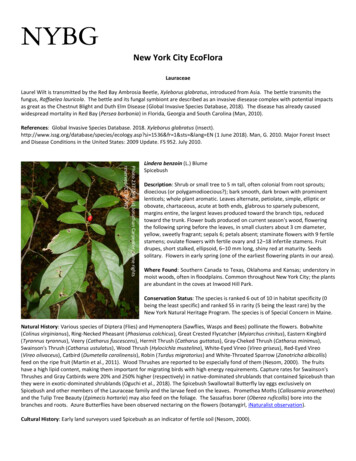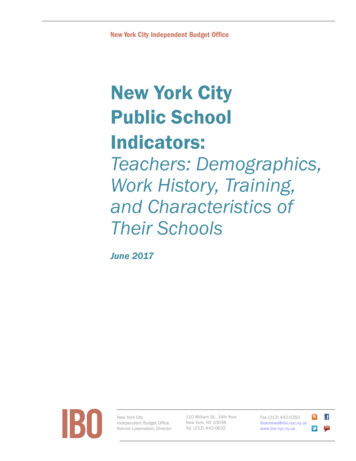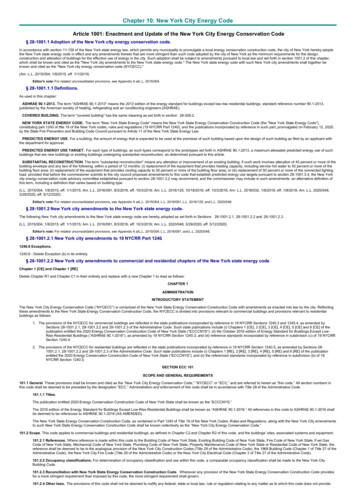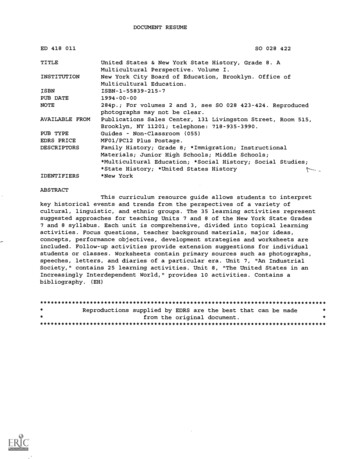
Transcription
New York City EcoFloraLauraceaeLaurel Wilt is transmitted by the Red Bay Ambrosia Beetle, Xyleborus glabratus, introduced from Asia. The bettle transmits thefungus, Raffaelea lauricola. The bettle and its fungal symbiont are described as an invasive diesease complex with potential impactsas great as the Chestnut Blight and Duth Elm Disease (Global Invasive Species Database, 2018). The disease has already causedwidespread mortality in Red Bay (Persea borbonia) in Florida, Georgia and South Carolina (Man, 2010).References: Global Invasive Species Database. 2018. Xyleborus glabratus ogy.asp?si 1536&fr 1&sts &lang EN (1 June 2018). Man, G. 2010. Major Forest Insectand Disease Conditions in the United States: 2009 Update. FS 952. July 2010.Photo 2377169, (c) Jonathan Carpenter, some rightsreserved (CC BY-NC)Lindera benzoin (L.) BlumeSpicebushDescription: Shrub or small tree to 5 m tall, often colonial from root sprouts;dioecious (or polygamodioecious?); bark smooth, dark brown with prominentlenticels; whole plant aromatic. Leaves alternate, petiolate, simple, elliptic orobovate, chartaceous, acute at both ends, glabrous to sparsely pubescent,margins entire, the largest leaves produced toward the branch tips, reducedtoward the trunk. Flower buds produced on current season's wood, floweringthe following spring before the leaves, in small clusters about 3 cm diameter,yellow, sweetly fragrant; sepals 6; petals absent; staminate flowers with 9 fertilestamens; ovulate flowers with fertile ovary and 12–18 infertile stamens. Fruitdrupes, short stalked, ellipsoid, 6–10 mm long, shiny red at maturity. Seedssolitary. Flowers in early spring (one of the earliest flowering plants in our area).Where Found: Southern Canada to Texas, Oklahoma and Kansas; understory inmoist woods, often in floodplains. Common throughout New York City; the plantsare abundant in the coves at Inwood Hill Park.Conservation Status: The species is ranked 6 out of 10 in habitat specificity (0being the least specific) and ranked S5 in rarity (5 being the least rare) by theNew York Natural Heritage Program. The species is of Special Concern in Maine.Natural History: Various species of Diptera (Flies) and Hymenoptera (Sawflies, Wasps and Bees) pollinate the flowers. Bobwhite(Colinus virginianus), Ring-Necked Pheasant (Phasianus colchicus), Great Crested Flycatcher (Myiarchus crinitus), Eastern Kingbird(Tyrannus tyrannus), Veery (Catharus fuscescens), Hermit Thrush (Catharus guttatus), Gray-Cheked Thrush (Catharus minimus),Swainson's Thrush (Catharus ustulatus), Wood Thrush (Hylocichla mustelina), White-Eyed Vireo (Vireo griseus), Red-Eyed Vireo(Vireo olivaceus), Catbird (Dumetella carolinensis), Robin (Turdus migratorius) and White-Throated Sparrow (Zonotricha albicollis)feed on the ripe fruit (Martin et al., 2011). Wood Thrushes are reported to be especially fond of them (Nesom, 2000). The fruitshave a high lipid content, making them important for migrating birds with high energy requirements. Capture rates for Swainson'sThrushes and Gray Catbirds were 20% and 250% higher (respectively) in native-dominated shrublands that contained Spicebush thanthey were in exotic-dominated shrublands (Oguchi et al., 2018). The Spicebush Swallowtail Butterfly lay eggs exclusively onSpicebush and other members of the Lauraceae family and the larvae feed on the leaves. Promethea Moths (Callosamia promethea)and the Tulip Tree Beauty (Epimecis hortaria) may also feed on the foliage. The Sassafras borer (Oberea ruficollis) bore into thebranches and roots. Azure Butterflies have been observed nectaring on the flowers (botanygirl, iNaturalist observation).Cultural History: Early land surveyors used Spicebush as an indicator of fertile soil (Nesom, 2000).
New York City EcoFloraName Notes: Spicebush is named for the spicy odor produced by terpenes and other compounds released when any part of theplant is bruised. The genus name Lindera commemorate the early Swedish botanist and physician, Johann Linder (1676–1723).Benzoic acid is an aromatic compound from various species of the Styrax genus native to Java, Sumatra and Thailand.Species Notes: A form of the species with pubescent leaves and twigs occurs primarily in the southeast and has been named Linderabenzoin var. pubescens (Palmer & Steyerm.) Rehder. A form with orange-yellow ripe fruits was named forma xanthocarpa (G.S.Torr.) Rehder and was recently found on Staten Island (Lynch, 2012). Two other species are rare shrubs in the southeastern US:Lindera melissifolia (Walt.) Blume, Pondberry or Southern Spicebush, and Lindera subcoriacea B.E. Wofford, Bog Spicebush.Spicebush is one of the first plants to bloom in spring, forming conspicious drifts of yellow among the bare trees and shrubs. TheCornelian Cherry (Cornus mas) produce masses of small yellow flowers around the same time as Spicebush, but can be distinguishedby the rough yellowish bark and opposite branching. Cornelian Cherry have not been found in the wild. Spicebush leaves turn abrilliant yellow color in the fall.Links: iNaturalist observations from New York City. Specimens from the Mid-Atlantic Herbaria Consortium. Globalbiotic interactions from GloBI.References: Nesom, G. 2000. Lindera benzoin (L.) Blume. Plant Guide. USDA NRCS National Plant Data Center & the Biota of NorthAmerica Program. https://plants.usda.gov/plantguide/pdf/pg libe3.pdf. Oguchi, Y., Z. Pohlen, R.J. Smith and J.C. Owen. 2018. Exoticand native-dominated shrubland habitat use by fall migrating Swainson's Thrushes and Gray Catbirds in Michigan, USA. The Condor120: 81–93. Lynch, R. 2012. A Rare Find: Yellow-Fruited Spicebush (Lindera benzoin forma xanthocarpum). Arnoldia 69(3): 24–28.Martin, A.C., H.S. Zim and A.L. Nelson. 2011. American Wildlife and Plants: A Guide to Wildlife Food Habits. Dover Publications. 512pp.Photo 9854294, (c) Harlan Svoboda, somerights reserved (CC BY-NC)Sassafras albidum (Nutt.) NeesSassafrasDescription: Trees to 20 m tall, the trunk sometimes becoming 1 m in diameter;often colonial from rootstock; dioecious; bark cinnamon-colored, with thickbriaded ridges; twigs yellowish green with prominent lenticels; terminal budsovoid, ca 1 cm diameter, yellow-green; whole plant aromatic. Leaves alternate,simple, polymorphic, sometimes un-lobed and elliptic, bi-lobed (mitten) or trilobed, coriaceous, tapered to the base, the margins entire, dark green above,paler beneath. Flowers usually before the leaves, in racemes, fragrant,greemish-yellow, the pedicels elongating in fruit, turning bright red; sepals 6;petals absent. Fruit fleshy, ellipsoid drupes, about 1 cm long, turning shiny, blueblack.Where found: Southern Canada to Florida, Texas, Oklahoma and Kansas; lightgaps in woods, fields and roadsides, usually in sandy, well-drained soil;intolerant of shade.Conservation Status: The species is ranked 4 out of 10 in habitat specificity (0being the least specific) and is ranked S5 in rarity (5 being the least rare) by theNew York Natural Heritage Program.Natural History: Sassafras are often found in large colonies, particularly afterfire. The Sassafras borer (Oberea ruficollis), Spicebush Swallowtail (Papilio troilus), Tiger Swallowtail (Papilio glaucus), Io Moth(Automeris io), Promethea Moth (Callosamia promethea), Drexel's Datana (Datana drexelii), Imperial Moth (Eacles imperialis), TulipTree Beauty (Epimecis hortaria), Cecropia Moth (Hyalophora cecropia), Small Necklace Moth (Hypsoropha hormos), Crinkled FlannelMoth (Lagoa crispata), Common Metarranthis (Metarranthis hypocharia), Pale Metarranthis (Metarranthis indeclinata), WoodgrainLeafroller (Pandemis lamprosana), Sassafras Leafroller Moth (Phaecasiophora niveiguttana), Tortricid Moth sp. (Sparganothissaracana) feed on leaves (Hilty, 2018). White-tailed Deer and Rabbits will browse the leaves and Beaver will gnaw on the bark.Bobwhite, Wild Turkey and many songbirds eat the fruit. The flowers are pollinated by small Halictid and Adrenid bees and a varietyNEW YORK BOTANICAL GARDENPage 2
New York City EcoFloraof flies, including Syrphid Flies, March Flies, Dance Flies, Tachinid Flies, Flesh Flies, Blow Flies, and Muscid Flies as well as Sawflies,Ichneumonid Wasps, and Beetles (Hilty, 2018).Cultural History: The wood was used for a variety of products. Oil of Sassafras is extracted from the roots and has been used inperfumes, teas and other beverages. Large quantities of the oil are reported to be carcinogenic.Name Notes: The genus name is derived from the name used by early French and Spanish settlers and probably derived from aNative American name. The specific epither, albidum, refers to the whitish undersides of the leaves.Species Notes: The leaves turn brilliant orange and red in the fall. There are three extant species in the genus, one in North Americaand two in Asia.Links: iNaturalist observations from New York City. Specimens from the Mid-Atlantic Herbaria Consortium. Globalbiotic interactions from GloBI.References: Hilty, J. 2018. Illinois Wildflowers. assafras.htm, accessed 1 June 2018.NEW YORK BOTANICAL GARDENPage 3
New York City EcoFloraPapilionidaePhoto 17830117, (c) Greg Lasley, some rightsreserved (CC BY-NC)Papilio troilus L.Spicebush Swallowtail ButterflyThroughout its lifecycle, the Spicebush Swallowtail Butterfly displays anequisite array of morphological and behavioral adaptations, making itone of our most beautiful and interesting Butterflies. It is native to theeastern half of the United States from southern Canada to Florida,Texas and Kansas. Caterpillars feed exclusively on species of the smalland restricted Laurel family (Lauraceae) and yet it is one of the mostcommonly observed butterflies in North America-- even breeding inCentral Park.Spicebush Swallowtails are in the large, mostly tropical Swallowtailfamily (Papilionidae). The family numbers over 500 species, includingthe largest of all butterflies, the Queen Alexandra's Birdwing of PapauNew Guinea whose wing span may exceed 30 cm. Adult butterflies aremostly large and attractive while the caterpillars are slow moving andcolorful. Many Swallowtails co-evolved with particular host plants and(c) Dave Govoni, some rights reserved (CC BY-NC-SA)are dependent on them, especially as caterpillars. Black Swallowtailfeed primarily on members of the Carrot family (Apiaceae) especiallyDill and Fennel. Caterpillars of our Eastern Tiger Swallowtails are less particular, feeding on members of the Magnolia (Magnoliaceae),Rose (Rosaceae), Olive (Oleaceae) and others. All three may be commonly seen in New York City. The less common PipevineSwallowtail feed exclusively on members of the Pipevine family (Aristolochiaceae) which are rare in our area.Adult females use chemoreceptors in their forelegs to select young Spicebush and Sassafras leaves upon which to lay their eggs. Therelatively large, smooth spherical eggs are oviposited under the leaf. The hatched larvae chew through the leaf from the edge to themidrib on the upper surface. Early instars of the larvae are brown and slimy, resembling bird droppings and when disturbed emit afoul odor.As the caterpillars pass through later stages of development (instars), they laydown a layer of silk along the midrid of the upper leaf surface. The drying silkcontracts and rolls the leaf upward, sheltering the larvae during the day. Theyemerge from their protective leaf at night to feed and when disturbed extendtheir osmeterium--a reddish, antennae-like structure resembling the forkedtongue of a snake. In their final stage, the caterpillar turns yellow-green anddevelops the characteristic eye-spots and coloration that resemble snake eyes.The mimicry is so evolved the eye-spots even have white patches within a dark"pupil" giving the "eyes" a moist and more authentic appearance. These areprobably the best snake mimics of all North American insects.Ansel Oommen, Bugwood.orgNEW YORK BOTANICAL GARDENPage 4
New York City EcoFloraThe final instars pupate just off the ground, emmitting a line of silk while turning aroundto crate a harness holding them fast. Summer pupae are green like the surroundingvegetation. Winter pupae are brown and will enter diapause to "hibernat" until spring.The entire process from egg to adult lasts about one month. The adults live from twodays to two weeks, relying on a variety of plants for nectar while searching for mates.The adults also display a highly evolved form of mimicry. Their size, shape and coloringresembles those of the foul-tasting and poisinous Pipevine Swallowtail (Battusphilenor) which birds soon learn to avoid.In our region, Spicebush Swallowtail (top map) feed exclusively (as caterpillars) onSpicebush (center map) and Sassafras (bottom map), while those further south alsoutilize Bay Laurel (Persea barbonia), Swamp Bay (Persea palustris), Southern Spicebush(Lindera melissifolia) and the introduced Camphor Tree (Cinnamomum camphora).Ansel Oommen, Bugwood.orgNEW YORK BOTANICAL GARDENPage 5
New York City EcoFlora NEW YORK BOTANICAL GARDEN Page 2 Name Notes: Spicebush is named for the spicy odor produced by terpenes and other compounds released when any part of the plant is bruised. The genus name Lindera commemorate the early Swedish botanist and physician, Johann Linder (1676-1723). Benzoic acid is an aromatic compound from various species of the Styrax genus native to Java .










